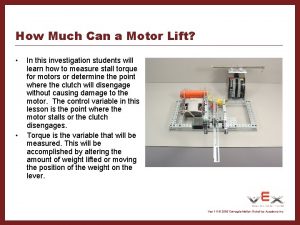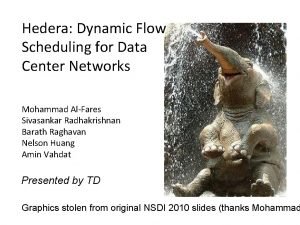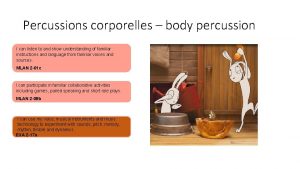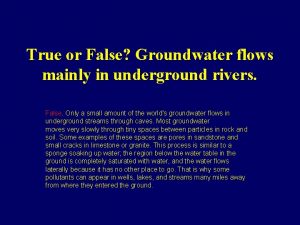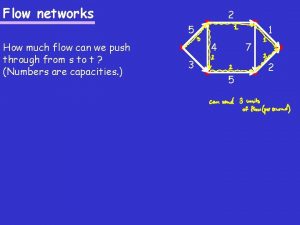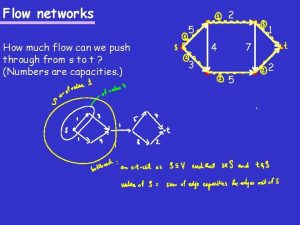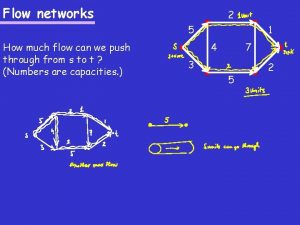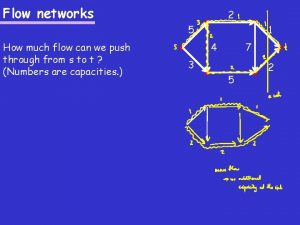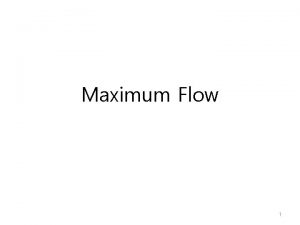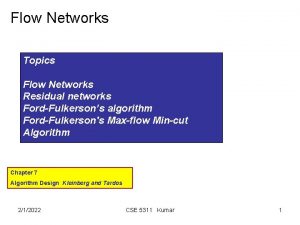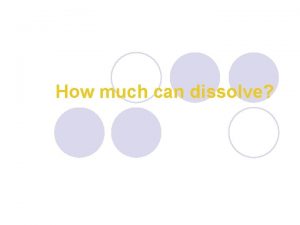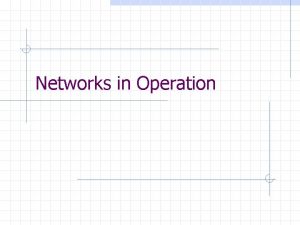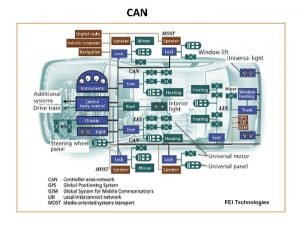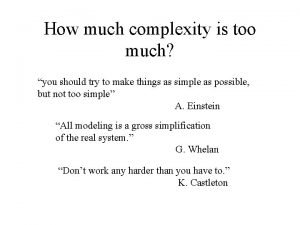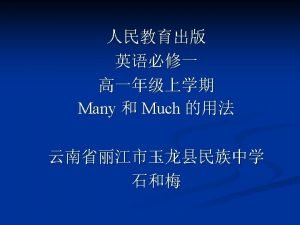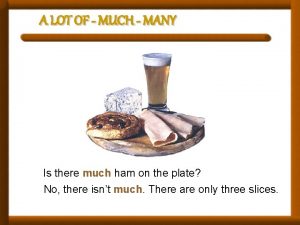Flow networks 2 5 How much flow can































- Slides: 31

Flow networks 2 5 How much flow can we push through from s to t ? (Numbers are capacities. ) 1 4 7 3 5 2

Flow networks 2 5 How much flow can we push through from s to t ? (Numbers are capacities. ) 1 4 7 3 5 3

Flow networks 2 5 How much flow can we push through from s to t ? (Numbers are capacities. ) 1 4 7 3 5 4

Flow networks 2 5 How much flow can we push through from s to t ? (Numbers are capacities. ) 1 4 7 3 5 7

2 Flow networks 5 s 1 4 7 3 5 Def: t 2 A flow network is a directed graph G=(V, E) where edges have capacities c: E->R+. There are two specified vertices s (source) and t (sink). A flow f: E->R must satisfy: • Capacity constraint: for every edge e: f(e) · c(e) • Flow conservation : for every v in V-{s, t}: e out of v f(e) = e into v f(e) The value of the flow is: e out of s f(e)

Maximum flow problem 2 Input: a flow network G=(V, E), with capacities c, the source s and sink t Output: a maximum-value flow Algorithm ? 5 s 1 4 7 3 5 t 2

Maximum flow problem – Ford-Fulkerson “Def”: 2 Given a flow f, an augmenting path is a path s=v 1, v 2, …, vk=t such that s f(vi, vi+1) < c(vi, vi+1) for i=1, …, k-1 5 1 4 2 3 5 Ford-Fulkerson ( G=(V, E), c, s, t ) 1. Initialize flow f to 0 2. While exists augmenting path p do 3. Augment flow f along p 4. Return f t 7

Maximum flow problem – Ford-Fulkerson 2 “Def”: Given a flow f, an augmenting path is a path s=v 1, v 2, …, vk=t such that s f(vi, vi+1) < c(vi, vi+1) for i=1, …, k-1 5 1 4 2 3 5 How to find augmenting paths ? Ford-Fulkerson ( G=(V, E), c, s, t ) 1. Initialize flow f to 0 2. While exists augmenting path p do 3. Augment flow f along p 4. Return f t 7

Maximum flow problem – Ford-Fulkerson “Def”: Given is G=(V, E), c, f. The residual graph has edges s weighted by the residual capacities, i. e. cf(e) = c(e)-f(e) 2 5 1 4 2 3 Ford-Fulkerson ( G=(V, E), c, s, t ) 1. Initialize flow f to 0 2. While exists augmenting path p do 3. Augment flow f along p 4. Return f 5 t 7

Maximum flow problem – Ford-Fulkerson 2 “Def”: Given is G=(V, E), c, f. The residual graph has edges s weighted by the residual capacities, i. e. cf(e) = c(e)-f(e) 5 1 4 2 3 Idea: Find an s-t path in the residual graph! Ford-Fulkerson ( G=(V, E), c, s, t ) 1. Initialize flow f to 0 2. While exists augmenting path p do 3. Augment flow f along p 4. Return f 5 t 7

Maximum flow problem – Ford-Fulkerson Consider this input: 1000 s 1 1000 Ford-Fulkerson ( G=(V, E), c, s, t ) 1. Initialize flow f to 0 2. While exists augmenting path p do 3. Augment flow f along p 4. Return f t 1000

Maximum flow problem – Ford-Fulkerson Consider this input: 1000 Need to refine the definition of augmenting paths and residual graph. s 1 1000 Ford-Fulkerson ( G=(V, E), c, s, t ) 1. Initialize flow f to 0 2. While exists augmenting path p do 3. Augment flow f along p 4. Return f t 1000

Maximum flow problem – Ford-Fulkerson Refined def: Given is G=(V, E), c, f. The residual graph Gf=(V, E’) contains the following edges: • forward edge: if e 2 E and f(e) < c(e) then include e in E’ with weight cf(e) = c(e)-f(e), • backward edge: if e=(u, v) 2 E with f(e)>0 then include (v, u) in E’ with weight cf(v, u) = f(u, v). 1000 s 1 1000 t 1000

Maximum flow problem – Ford-Fulkerson ( G=(V, E), c, s, t ) 1. For every edge e let f(e)=0 2. Construct the residual graph Gf 3. While exists s-t path in Gf do 4. Let p be an s-t path in Gf 5. Let d=mine in p cf(e) 6. For every e on p do 7. If e is a forward edge then 8. f(e)+=d 9. else 10. f(reverse(e))-=d 11. Update Gf (construct new Gf) 12. Return f

Maximum flow problem – Ford-Fulkerson ( G=(V, E), c, s, t ) 1. For every edge e let f(e)=0 2. Construct the residual graph Gf 3. While exists s-t path in Gf do 4. Let p be an s-t path in Gf 5. Let d=mine in p cf(e) 6. For every e on p do 7. If e is a forward edge then 8. f(e)+=d 9. else 10. f(reverse(e))-=d 11. Update Gf (construct new Gf) 12. Return f Running time:

Maximum flow problem – Ford-Fulkerson 1000 s 1 1000 t 1000

Maximum flow problem – Ford-Fulkerson Lemma: 2 5 Ford-Fulkerson works. s 1 4 7 3 5 Ford-Fulkerson ( G=(V, E), c, s, t ) 1. Initialize flow f to 0 2. While exists augmenting path p do 3. Augment flow f along p 4. Return f t 2

Maximum flow problem – Ford-Fulkerson 2 Lemma: 5 Ford-Fulkerson works. s Def: Given G=(V, E), c. An s-t cut of G is a subset of vertices S s. t. s 2 S and t 2 SC. Its value is e out of S c(e) 1 4 7 3 5 t 2

Maximum flow problem – Ford-Fulkerson 2 Lemma: 5 Ford-Fulkerson works. s Let min-cut(G) be the minimal value of an s-t cut of G. Then: iff 4 7 3 The Max-flow min-cut theorem: f is a maximum flow 1 5 value(f)=min-cut(G) t 2

Improving Ford-Fulkerson Can find better paths to reduce the running time? 2 5 s 1 4 7 3 5 Ford-Fulkerson ( G=(V, E), c, s, t ) 1. Initialize flow f to 0 2. While exists augmenting path p do 3. Augment flow f along p 4. Return f t 2

Improving Ford-Fulkerson Can find better paths to reduce the running time? - many ways, will discuss two: - Scaling paths 2 5 s 1 4 7 3 - BFS Ford-Fulkerson ( G=(V, E), c, s, t ) 1. Initialize flow f to 0 2. While exists augmenting path p do 3. Augment flow f along p 4. Return f 5 t 2

Improving Ford-Fulkerson Can find better paths to reduce the running time? - many ways, will discuss two: - Scaling paths 2 5 s 8 4 7 3 5 Ford-Fulkerson ( G=(V, E), c, s, t ) 1. Initialize flow f to 0 2. While exists augmenting path p do 3. Augment flow f along p 4. Return f t 2

Improving Ford-Fulkerson 2 Can find better paths to reduce the running time? - many ways, will discuss two: - Scaling paths 5 s 1 4 7 3 - BFS 5 t 2 Thm: Edmonds-Karp takes O(|V||E|) iterations. Running time of Edmonds-Karp: Edmonds-Karp ( G=(V, E), c, s, t ) 1. Initialize flow f to 0 2. While exists augm. path p (check with BFS) do 3. Augment flow f along p 4. Return f

Applications of Network Flows • multiple sources, multiple sinks s 1 t 1 s 2 t 2 s 3 t 4

Applications of Network Flows • how to find minimum cut 2 5 s 1 4 7 3 5 t 7

Applications of Network Flows • maximum number of edge-disjoint s-t paths s t

Applications of Network Flows • maximum bipartite matching

Applications of Network Flows • maximum weighted (perfect) bipartite matching 7 5 2 3 4 4 1 6 3 8

Introduction to Linear Programming Consider the Diet problem: - n food items, m nutrients - for every nutrient: the daily quota bj - for each item: cost per pound ci - for every item and nutrient: how much of the nutrient in a pound of item: ai, j

Introduction to Linear Programming A linear program looks like this: Find x 1, x 2, …, xm which • maximize c 1 x 1 + c 2 x 2 + … + c m x m • and satisfy these constraints: a 1, 1 x 1 + a 1, 2 x 2 + … + a 1, mxm · b 1 a 2, 1 x 1 + a 2, 2 x 2 + … + a 2, mxm · b 2 … an, 1 x 1 + an, 2 x 2 + … + an, mxm · bn

Introduction to Linear Programming A linear program in compressed form: Given a vector c in Rm, a vector b in Rn and a matrix A in Rn x m, find a vector x in Rm which satisfies x. AT · b and maximizes cx. T. Thm: Exists a polynomial-time algorithm solving linear programs. Caveat: Sometimes need integer programs (no algorithm for integer programs is likely to exist) !
 Difference between virtual and datagram circuit
Difference between virtual and datagram circuit Basestore iptv
Basestore iptv How much caffeine in a snickers bar
How much caffeine in a snickers bar To whom much is given much is expected meaning
To whom much is given much is expected meaning How much is too much plagiarism
How much is too much plagiarism How much can they safely carry answer key
How much can they safely carry answer key How much is this
How much is this Potassium sources in food
Potassium sources in food How much can industry
How much can industry A day with nandu lesson plan
A day with nandu lesson plan How much can you remember about last year
How much can you remember about last year Hedera: dynamic flow scheduling for data center networks
Hedera: dynamic flow scheduling for data center networks If you can imagine it you can achieve it
If you can imagine it you can achieve it You can tell harris about it just ____(easily) as i can
You can tell harris about it just ____(easily) as i can If you think you can you can poem
If you think you can you can poem If you can't measure it quote
If you can't measure it quote If you can't measure it you cannot improve it
If you can't measure it you cannot improve it Can can body percussion
Can can body percussion The arrangement of the elements of curriculum
The arrangement of the elements of curriculum You can tell harris about it just ____(easily) as i can.
You can tell harris about it just ____(easily) as i can. How to be more impressive 1+1=2
How to be more impressive 1+1=2 He can speak
He can speak Look at the pictures and complete with can or can't
Look at the pictures and complete with can or can't We're going on a bear hunt lyrics
We're going on a bear hunt lyrics Through you i can do anything
Through you i can do anything If you can't measure it you cannot improve it
If you can't measure it you cannot improve it Already can or can already
Already can or can already Any fool can write code that a computer can understand
Any fool can write code that a computer can understand Sonnet 18 figures of speech
Sonnet 18 figures of speech Vertikale bilanzkennzahlen
Vertikale bilanzkennzahlen Modal verbs can can't
Modal verbs can can't Most groundwater comes from rain true or false
Most groundwater comes from rain true or false






